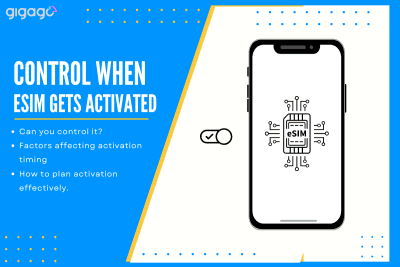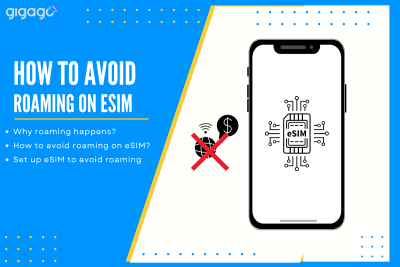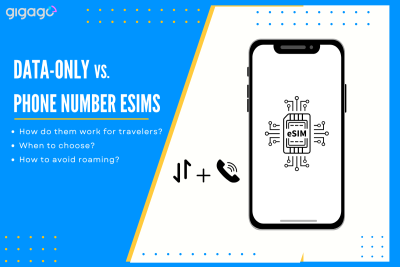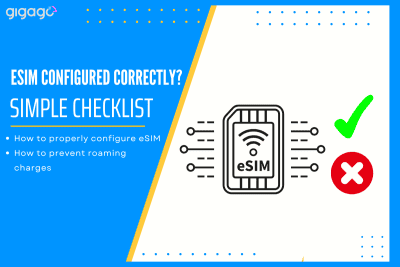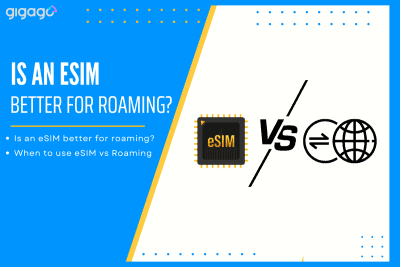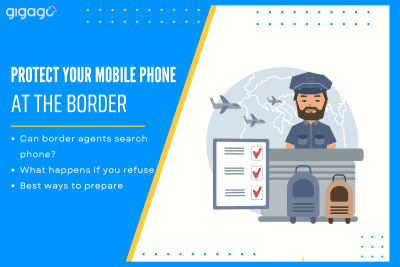Controlling when your eSIM activates is key to managing your mobile connectivity effectively. This guide answer the question “Can I control when my eSIM gets activated?” and explain why and how you can control eSIM activation, along with related questions to help you use eSIMs confidently. I. Why do you need to control when your […]
Comparison of Pocket Wifi vs eSIM: Which is Better?
We explain the advantages and disadvantages of a pocket WiFi vs eSIM to help you decide which connectivity option to choose for your international travel.
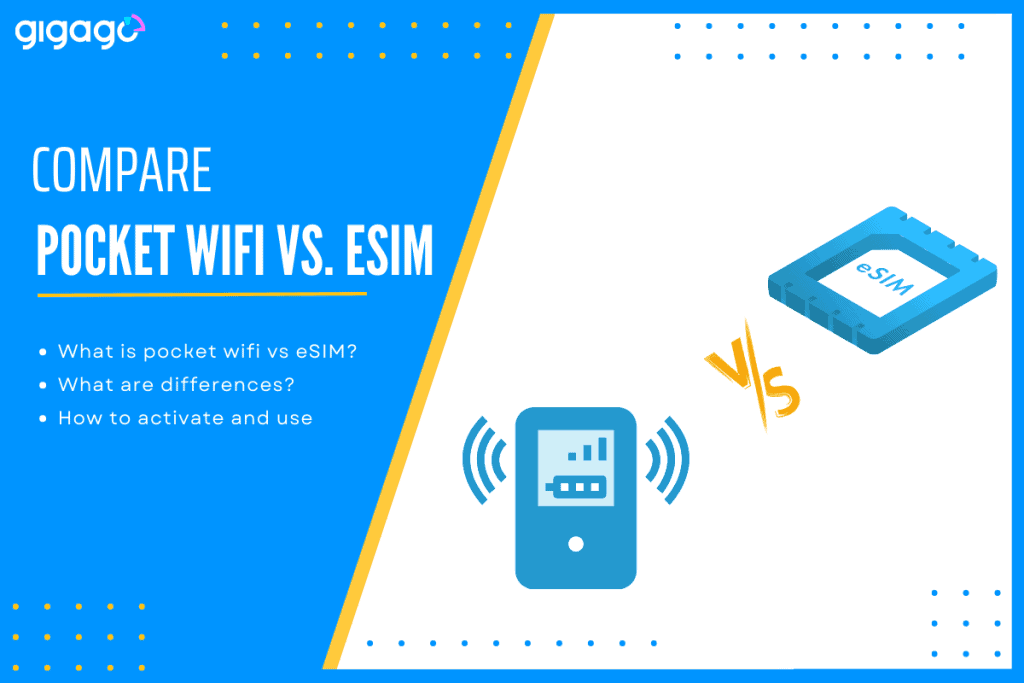
Staying connected while traveling internationally is vital among travelers. Whether it is for business purposes or simple to stay in touch with people back home, having access to the Internet is important.
There are two popular connectivity options for tourists abroad which are pocket WiFi and travel eSIM. This article will compare and contrast pocket WiFi vs eSIM to help you decide which is better for your upcoming trip.
In this article
I. Overview Of Pocket Wifi And An eSIM
Before finding the differences between a pocket WiFi and an eSIM, you should have a general understanding about these connectivity options.
A pocket WiFi is a portable device that provides WiFi hotspot, allowing multiple devices to connect to the Internet simultaneously. It uses a physical SIM card to connect to a cellular network and provide internet access. The browsing speed can be 3G, 4G/LTE or 5G depending on your destination and the selected plan. Its battery runs from 8 to 13 hours depending on the device’s capacity.
Pocket WiFi devices are small and easy to carry, making them a convenient connectivity option for tourists who need to stay connected on the go. However, they do require charging and need to keep track of.
An eSIM (embedded SIM) is a virtual SIM card built into compatible mobile devices. Unlike traditional physical SIM cards, eSIM do not need to be inserted or removed. Rather than, they can be activated and managed remotely through the device’s settings. For abroad travel, people often choose prepaid data eSIM for the best convenience and cost effectiveness.
This newly developed SIM card is convenient and flexible for usage. However, eSIMs are only available on compatible devices. You can either look for your phone model in this eSIM compatibility checklist or learn quick ways to check if your phone supports eSIM by yourself.
II. Differences Between A Pocket Wifi Vs An eSIM
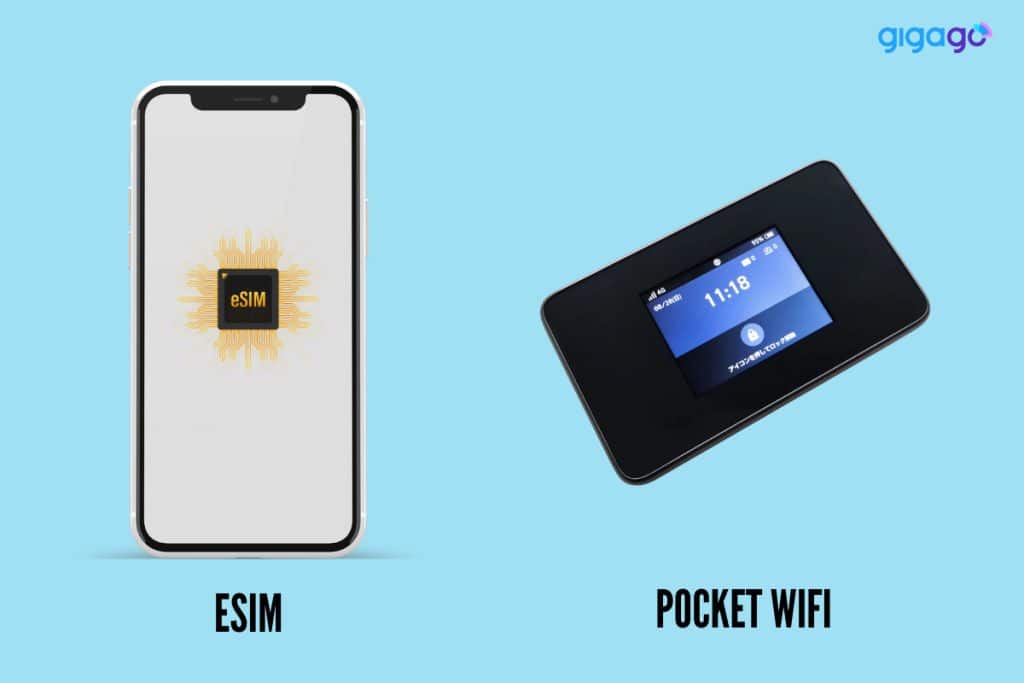
Below we make a comparison table between a pocket WiFi an eSIM:
| Feature | Pocket WiFi | eSIM (data) |
| Form factor | Physical device | Embedded in compatible mobile devices |
| SIM card | Required | Not required |
| Data Capacity | Provides ample data capacity, with options exceeding 100GB of data | Offers smaller data capacities because of a short-term usage, with option around 50GB of data |
| Usage validity | Suitable for people on short trips and long trips | Designed for people on short stays of less than 30 days |
| Activation | Requires manual insertion of SIM card | Remote activation through device settings |
| Convenience | Easy to share internet with multiple devices | No need to carry or swap physical SIM cards |
| Compatibility | Works with most devices | Only works with compatible devices |
| Ideal for | People traveling in groups or with multiple devices | People with compatible devices who prefer a hassle-free experience |
| Internet without roaming charges | Yes | Yes |
| Internet connection sharing | Yes/No | Yes |
| Flexible plans | Yes | No |
| Instant delivery | Yes | No |
| Shipping fees | No | Yes |
| Potential extra fees | No | Yes (fee in case of loss) |
To help you have a clear understanding about the differences between mobile WiFi and eSIM card, below we make a comparison between these two option in terms of speed and coverage in different popular countries:
| Country | Pocket WiFi Speed | eSIM Speed | Pocket WiFi Coverage | eSIM Coverage |
| United States | Up to 100 Mbps | Up to 500 Mbps | Good | Excellent |
| United Kingdom | Up to 150 Mbps | Up to 300 Mbps | Good | Excellent |
| Japan | Up to 200 Mbps | Up to 1 Gbps | Excellent | Excellent |
| South Korea | Up to 300 Mbps | Up to 1 Gbps | Excellent | Excellent |
| China | Up to 100 Mbps | Up to 300 Mbps | Good | Limited |
From the table above, it can be said that both pocket WiFi and eSIM are great options for staying connected while abroad. However, eSIM typically offer faster speeds than pocket WiFi devices. It is because eSIMs use the same cellular network as your phone, which is faster than the WiFi network that the portable WiFi devices use.
Besides, eSIMs also have better coverage than pocket WiFi. This is because eSIMs can connect to any cellular network that your phone can connect to while pocket WiFi devices can only connect to the cellular network available in the surrounding area.
III. How Much Is Pocket Wifi Vs eSIM?
The cost of renting a pocket WiFi is from $5-20 per day with a typical data plan ranging from 1GB to unlimited data. Rentals are available for 1 to 30 days.
The cost of an eSIM is from $3.5 with a typical data plan ranging from 1GB to 50GB or even unlimited data. Popular usage validity is from 1 day to 30 days.
In fact, the cost of renting a pocket WiFi vs an eSIM varies depending on the provider, data plan, and the duration of your trip.
Though eSIMs are typically more expensive than a pocket WiFi, they offer faster speeds, better coverage and more convenience.
Below we compare the costs of renting a pocket WiFi vs. an eSIM from some popular providers which offer both pocket WiFi and eSIM services:
| Provider | Pocket WiFi | eSIM |
| Travel WiFi | $10-$15 per day | $20-$30 per month |
| Xfinity | $10-$15 per day | $25-$40 per month |
| Verizon | $15-$20 per day | $30-$50 per month |
| AT&T | $10-$15 per day | $25-$40 per month |
| T-Mobile | $10-$15 per day | $25-$40 per month |
Note: These prices are subject to change. Be sure to compare prices from multiple providers before making a decision.
However, the best advice is to buy eSIM from a specialized eSIM provider for the best cost because these providers typically offer lower prices than cellular carriers. This is because eSIM providers often have partnerships with multiple cellular carriers, which allows them to offer a wider range of plans and prices.
IV. Where To Buy Pocket WiFi vs eSIM?
You can either buy or rent a pocket WiFi device for your international travel.
- Buy a pocket WiFi if you are a frequent traveler for the most convenience. You can buy a pocket WiFi through ecommerce platforms like Amazon, eBay, Mercado Libre, and other retailers. Then, sign up a data plan through a mobile network operator or an internet service provider.
- Rent a pocket WiFi if you are traveling on a short trip. In each country, there are domestic and international providers for you to choose from. Remember to rent pocket WiFi before your departure because you need enough time to get it. This way, you have two options to get the device, either have it delivered to a physical address or pick it up at an authorized location (like an airport).
For example, if you travel to the United States, you can rent a pocket WiFi from Travel WiFi, Xfinity, Google Fi, Verizon, AT&T, T-Mobile, MioFi, Skyroam, WiFi To Go, Tep Wireless, etc. These providers offer a variety of pocket WiFi devices for a flat fee per day. The data plans are often unlimited and can be used in 50 states of the country. To rent a pocket WiFi device from one of these providers, you can visit their website, select the device you want to rent. Then, choose the dates you will travel and pay for your rental. Once you place an order, the provider will ship it to you before your trip. When you finish your trip, return it back to the provider using the prepaid shipping method that they provide.
Note: When choosing a pocket WiFi provider, make sure you compare prices, data plans and coverage areas to find the best option for your needs.
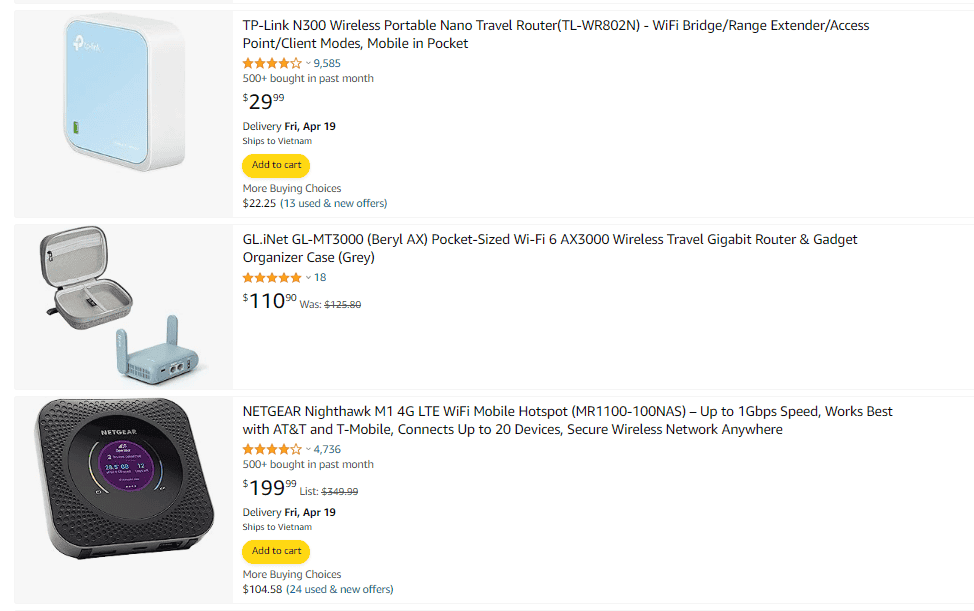
To buy an eSIM, you have two options:
- Buying from your home network carrier directly, or
- Buying from a reputable eSIM provider such as Gigago, which does not require you to show any personal documents for registration and verification. All you have to do is to search for your destination, check the data plans on offer, add one to the shopping cart and make a purchase like you would do with any other e-commerce site. With an eSIM, no matter if you travel to a single country or a region, there are always suitable options to choose from.
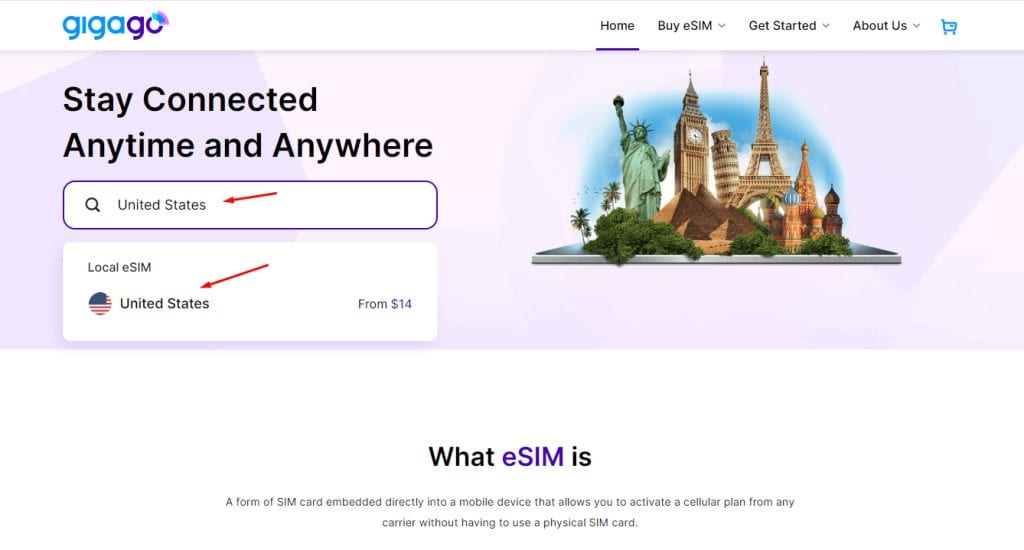
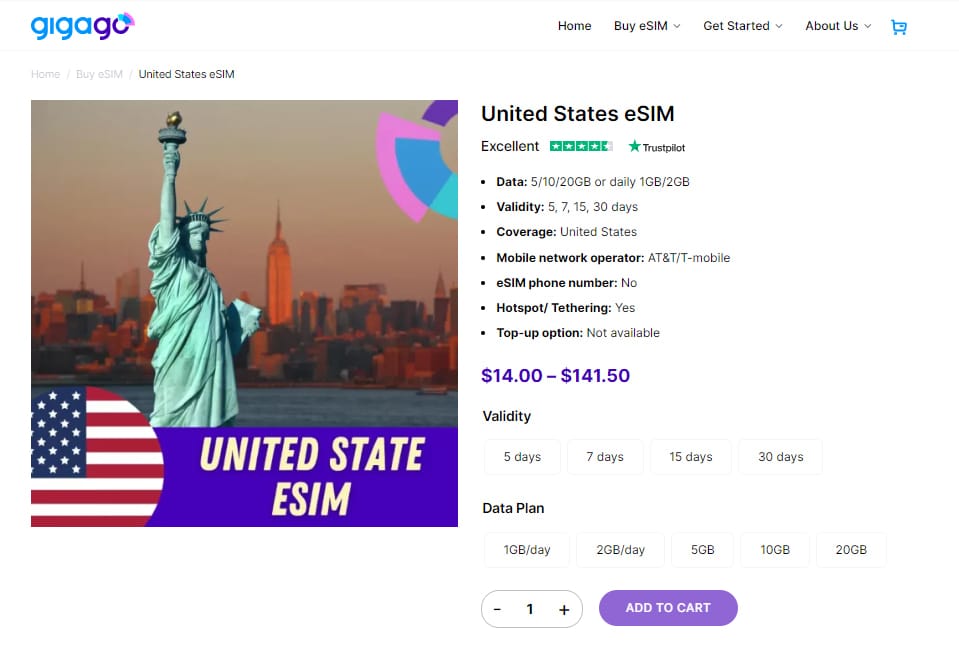
VI. How To Use A Pocket Wifi vs eSIM
The way to use a pocket WiFi device is very simple and straightforward. You just need to take the following steps:
- Rent or buy a pocket WiFi device
- Insert a SIM card into the pocket WiFi device. If you rent a pocket WiFi device, the sim card will be included in advance. If you buy a pocket WiFi device, you will need to buy a separate SIM card.
- Turn on the device. The pocket WiFi after being turned on will create a WiFi network to allow other mobile devices like phones, tablets, or laptops to connect
- Connect to the pocket WiFi network
- Start enjoying the internet
The way to use an eSIM is also easy and straightforward. Take the steps below:
- Buy an eSIM plan from a reputable eSIM provider like Gigago
- Install the eSIM on your phone by scanning the QR code or enter activation code manually (which will be sent to your registered email address)
- Activate the eSIM by following the on-screen instructions
- Start using the eSIM
► Our conclusion:
eSIMs are easier and more convenient to use for international travelers with compatible devices. However, pocket WiFi is a good option for travelers who need a device that can be used by multiple people.
VII. Pocket WiFi vs. eSIM – Which One Is Better For You?
Pocket WiFi is just one of your connectivity options for using local internet access while you are traveling abroad. The need to charge the item and carry it around every day makes it less appealing for data use during travel.
So which is the right option for you? A Pocket WiFi Device or an eSIM?
To sum up, the best option for Internet connection while traveling internationally will depend on your personal needs and other circumstances. For tourists, pocket WiFi is not worth it much. Instead, if your phone is compatible with eSIMs, you should choose eSIMs because you will be more flexible and once you are connected, all you need to do is top up – super convenient.
